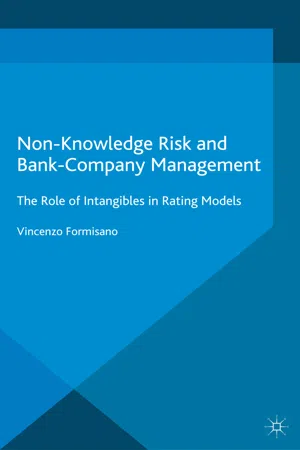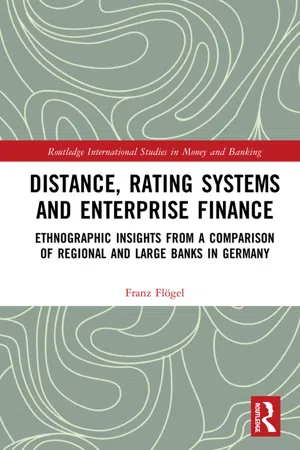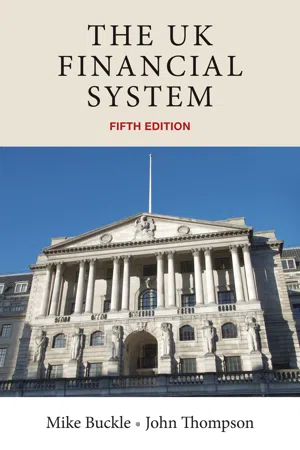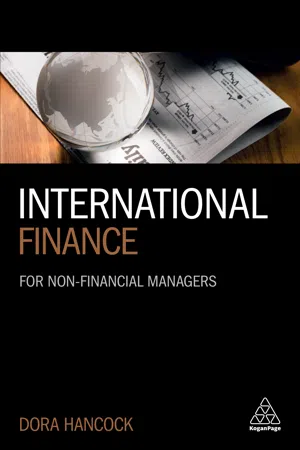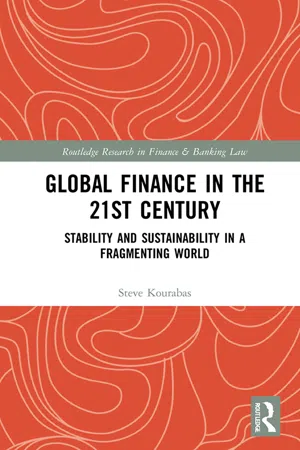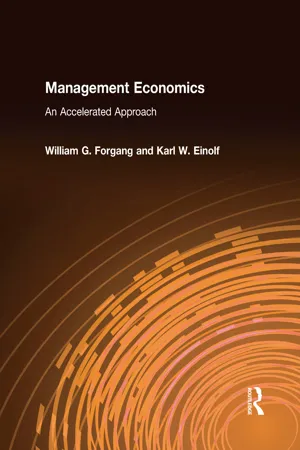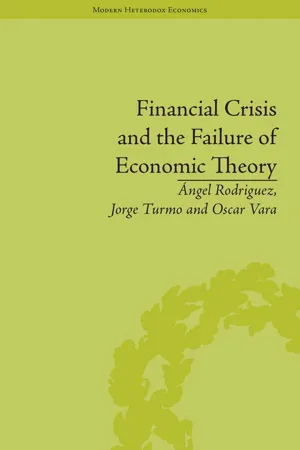Economics
Financial System
The financial system refers to the network of institutions, markets, and mechanisms that facilitate the flow of funds between savers and borrowers. It includes banks, stock exchanges, bond markets, and other financial intermediaries. The financial system plays a crucial role in allocating capital, managing risk, and promoting economic growth.
Written by Perlego with AI-assistance
Related key terms
9 Key excerpts on "Financial System"
- eBook - ePub
Non-Knowledge Risk and Bank-Company Management
The Role of Intangibles in Rating Models
- Vincenzo Formisano(Author)
- 2016(Publication Date)
- Palgrave Macmillan(Publisher)
1 The Context: The Financial System1.1 The viable Financial SystemThe functioning of the Financial System, given the nature of the activity, takes place in a context of rules and controls. The raison d’être of the Financial System is linked to the performance of certain functions that are critical, due to the way a modern economy of monetary exchange runs. These functions satisfy the specific needs of the economic system, thus allowing the development of production and distribution processes.The Financial System realizes, through the production and supply of financial services, three fundamental processes of the functioning of a modern economy: 1. Regulation of trade. 2. The accumulation of savings and investment financing. 3. Risk management. A system which bases its functionality on the specialization and diversity of positions must have highly developed and efficient mechanisms for exchange and regulation of trade.One of the factors behind the functionality of trade is the system of payments, and therefore the adequacy of monetary tools through which commercial transactions can be adjusted. One can understand the progress which has been possible, moving from a barter economy to a monetary one in which money is accepted as currency trading.Currency trading is able to measure the value of goods traded and is widely accepted as a settlement of a transaction. The theme of this evolution has been the search for new means of payment that can reduce transaction costs and make balancing less risky.The accumulation and allocation of savings constitute two fundamental aspects of the Financial System. They assume that the system creates the most favorable conditions in order to make correct decisions (Barile, 2009b), pertaining to: - eBook - ePub
Distance, Rating Systems and Enterprise Finance
Ethnographic Insights from a Comparison of Regional and Large Banks in Germany
- Franz Flögel(Author)
- 2018(Publication Date)
- Routledge(Publisher)
2 Financial Systems, the geography of firm financing and rating systems2.1 Financial Systems and economic development
Following Schmidt and Tyrell (2004: 21ff), the financial sector is defined as:That part – or sector – of an economy which offers and provides financial services to the other sectors of the economy. It consists of the central bank, other banks, non-bank financial institutions, organized financial markets and the relevant regulatory and supervisory institutions.The financial sector is one part of a Financial System. A Financial System in general is defined as “the interaction between the supply of and the demand for the provision of capital and other finance-related services” (Schmidt and Tyrell 2004: 21). In addition to the financial sector, a Financial System also comprises the demands of the users of financial services (e.g. savings and investment preferences) and the state that demands and regulates finance. Furthermore, the flows of information and influence (or power) that mirror financial flows belong to a Financial System (Schmidt and Tyrell 2004; Zademach 2014).This chapter elaborates on the connections between Financial Systems and economic development and focuses on the institutional design of Financial Systems. It shows the need of structural classifications of Financial Systems in light of “too much finance” (Arcand et al. 2012) and outlines the rationales for a geographical classification of banking systems in the context of the diversity in banking debate. Section 2.1.1 reviews the finance–growth nexus. Section 2.1.2 considers the structure of Financial Systems and indicates that several structural variables influence economic development. Section 2.1.3 demonstrates that the geographical classification explains the varying lending practices of decentralised and centralised banks and tends to be one relevant structural variable of Financial Systems. - eBook - ePub
The UK financial system
Theory and practice, fifth edition
- Mike Buckle, John Thompson(Authors)
- 2016(Publication Date)
- Manchester University Press(Publisher)
Chapter 1Introduction to the Financial System
1.1 IntroductionWe begin our study of the UK Financial System with an introduction to the role of a Financial System in an economy. The Financial System is at the heart of the economy, supplying finance, enabling transfers of payments and enabling agents to manage risk. In the UK economy, which has an international Financial System, that system also provides many jobs, and makes a significant contribution to the output of the country and the balance of payments. We start the introduction with a very simple model of an economy and then extend the analysis throughout the rest of this and the next chapter. A second objective is to establish some of the basic financial concepts which will be drawn upon throughout this book1.2 The role of the Financial SystemTo help us to understand the role played by a Financial System in a mature economy such as that of the UK we start by constructing a simplified model of an economy. In this model the economy is divided into two distinct groups or sectors. The first is the household sector, which is assumed to be the ultimate owner of all the resources of the economy. In the early stages of development of an economy the household unit would have undertaken production of any goods consumed. As economies have developed, a form of specialisation has generally taken place so that the proximate ownership and control of much of the productive resources of the economy, such as land, buildings and machinery, have been vested in units making up the second sector, which we call the firms sector. We will examine the financial relationships between these two sectors later. In our simple model it is the firms sector which organises the production of goods and services in the economy. In exchange for these goods and services, households hire out their resources of land, labour and so on. At this stage we ignore the role of the government and we assume that the economy is closed, so that there is no exchange of goods and services with other economies. The real flows in this simple economy are set out in the inner loop of figure 1.1 - eBook - ePub
Economy/Society
Markets, Meanings, and Social Structure
- Bruce G. Carruthers, Sarah Louise Babb(Authors)
- 2012(Publication Date)
- SAGE Publications, Inc(Publisher)
Banking and finance have both real-world importance and sociological relevance. Financial markets affect our lives at multiple levels—from the size of our retirement accounts to our prospects for finding jobs to whether we are able to obtain home mortgages. National Financial Systems aren’t all alike; in general they are organized around banks or capital markets (although modern Financial Systems almost always involve some of both). They perform the same functions (e.g., intermediation, saving, investment, risk management) but in different ways that can make national economies look very different.Individuals’ experience of financial markets depends not only on what country they live in but also on their social standing within that country. A person who can obtain credit commands purchasing power and benefits from all the advantages that come with it; such a person can make productive investments and enjoy higher levels of consumption. This privilege is not distributed evenly across the members of a society: Some people can obtain credit and others cannot. The crisis of 2008 brought into sharp relief a number of trends and vulnerabilities that allowed a downturn in the U.S. housing market to become a worldwide problem. That high level of interconnectedness is one of the hallmarks of a globalized economy: Events in one place can reverberate around the world. That crisis came after a long period in which the United States had deliberately dismantled much of the regulatory machinery it had put in place in response to a previous crisis (the Great Depression). For a time, this seemed like a good idea. Now, even some of the biggest supporters of deregulation during the 1980s and 1990s have had second thoughts (e.g., Alan Greenspan). But whether one thinks deregulation is a good idea or a bad one, it is clear that government plays a central and constitutive role in a country’s Financial System.Notes
1. A loan is said to be secured if the lender has the right to seize some asset belonging to the borrower in the event the borrower defaults on the loan. Such an asset is called the collateral for the loan. A loan secured by real estate is commonly termed a mortgage. - eBook - ePub
International Finance
For Non-Financial Managers
- Dora Hancock(Author)
- 2018(Publication Date)
- Kogan Page(Publisher)
02The institutions and participants that make up the global Financial System
At the end of this chapter you will be able to:- identify and discuss the participants in the global Financial System, particularly the role of central banks;
- discuss the need for banking regulation and supervision and the difficulties faced by legislators;
- briefly describe what happened in the global financial crisis.
Introduction
The Financial Times defines the global Financial System as:This is the interplay of financial companies, regulators and institutions operating on a supranational level. The global Financial System can be divided into regulated entities (international banks and insurance companies), regulators, supervisors and institutions like the European Central Bank or the International Monetary Fund. The system also includes the lightly regulated or non-regulated bodies – this is known as the ‘shadow banking’ system. Mainly, this covers hedge funds, private equity and bank-sponsored entities such as off-balance-sheet vehicles that banks use to invest in the financial markets.The global Financial System has grown over recent decades to meet the needs initially of international trade, and today to meet the complex needs of companies, investors, governments, banks and everyone seeking to borrow or invest money or to use a currency other than their domestic currency.One way or another almost all of us have some contact with the global Financial System. Holidaymakers will be affected by changes in exchange rates, finding their holiday more or less expensive than in previous years. Oil and fuel are priced in dollars so the fall in the value of sterling following the Brexit vote led to an increase in fuel prices across the UK. In practice, there are also links between the interest rates that different countries charge and this impacts on the cost of borrowing for most of us. - eBook - ePub
Global Finance in the 21st Century
Stability and Sustainability in a Fragmenting World
- Steve Kourabas(Author)
- 2021(Publication Date)
- Routledge(Publisher)
See , e.g., Australian Department of Treasury, ‘Financial System Inquiry: Final Report’ (Australian Government Publishing Service 1997) 185–86 (Australian Financial System Inquiry).2.3 Networked finance in the global era
Banking, financial and monetary practices have developed over several centuries, usually through bursts of innovation that have responded to crises and/or the need for economic growth and development.64 Several factors seem to have motivated early financial innovations, but in particular, the demands of nascent states, the increasing commercial needs of merchants, and the limitations inherent on the reliance on metal as a source of money appear to have played an important part in this financial evolution.65 Such innovations contributed to self-sustaining growth by expanding the repository of knowledge leading to an increasing return of scale.66The fruits of this growth can be witnessed through the speed at which innovation is currently taking place in the technological and financial space. These innovations are, however, in many respects, different to those that preceded them. Beginning with the digitisation of finance from the middle of the twentieth century, innovation has overcome a number of time and space-based obstacles to enable virtually instantaneously available financial services across the globe (so-called ‘financial globalisation’).67 Importantly, financial globalisation is characterised by increased cross-border capital flows and interconnectedness in the Financial System.68 This, together with a widely adopted shift in policy preference towards a more laisse faire - eBook - ePub
Management Economics: An Accelerated Approach
An Accelerated Approach
- William G. Forgang, Karl W. Einolf(Authors)
- 2015(Publication Date)
- Routledge(Publisher)
3Money and the Financial Markets
The previous chapter develops a model of the economy that explains short-term macroeconomic fluctuations through an income and expenditures approach. The prior chapter does not consider (1) the role of money in facilitating transactions in the goods or resource markets, (2) interest rates, monetary policy, and economic fluctuations, (3) the process by which funds flow from savers to investors, or (4) the mechanics of financing government budgetary deficits. This chapter fills the gaps.Learning ObjectivesThe successful reader understands:• The structure and operations of the money and Financial Systems and the role of money and interest rates in the economy• Monetary policy and its effects on a firm’s operating environment• The money and Financial System as environments within which business and personal investment occurAn understanding of how money and credit interact with real economic activity is fundamental to management responsibilities. Business decisions dependent upon money and credit conditions include the management of a firm’s cash position, extending and receiving credit, establishing the appropriate debt-to-equity ratio, and planning for the firm’s long-term physical and financial capital needs. However, the importance of money and credit extends well beyond financial management decisions. The demand for many products is sensitive to the price and availability of credit, and decisions in production, procurement, hiring, and inventory control are made within the monetary and financial environments. Further, personal financial planning and investment decisions are made within these environments and include the timing of buying goods on credit, choosing a fixed-or variable-rate mortgage, selecting stocks, and choosing the maturity of financial investments.Two sets of issues are covered in this chapter. The flow of funds section of this chapter examines the institutions and markets that facilitate the transmission of foreign and domestic savings to companies for investment in plant and equipment, to government to finance public debt, and to households for purchases of homes, cars, and other durable products. The second section of this chapter examines the role of money in the economy, monetary policy, and interest rates. - Jorge Turmo Arnal(Author)
- 2015(Publication Date)
- Routledge(Publisher)
Textbooks on finance and the Financial System include money and money markets among other issues, for instance banking, stock markets and currency exchange markets. We have shown in the previous epigraphs that our textbook, the Financial System, has increased considerably in size and complexity. If we use it as a metaphor, the textbook becomes continuously larger and the share of money and money markets shrinks.What happens to economic theory? To a certain extent we have answered this question in the preceding sections, because we have explained the scope of micro-economic theory and macroeconomic theory on this issue. But we want here to summarize and organize the main ideas. The first issue is that microeconomic theory deals, to a certain extent, with the Financial System, while macroeconomics does not. Macroeconomics takes into account only money and money markets.11 As a consequence, the main macroeconomic models, the ones that policymakers, international organisms and advising firms use, display a serious weakness. When the Financial System was a small part of the whole economic system, this weakness was negligible and theorists could fare well without modelling the Financial System. This is not true anymore. Macroeconomic models, no matter their aggregation level, must be fixed by incorporating the Financial System into them. The financial crisis has proven that financial phenomena exert a very large influence on the normal running of economies, far more than it was supposed to do. Many theorists have compared our crisis with the Great Depression. There are some similarities but in our opinion the largest difference is the role played by the Financial System in our Great Recession. The interconnectedness of the worldwide Financial System has created a strong negative feedback loop that has harmed many countries for many years. Still more meaningful is the fact that financial troubles have driven the crisis. It is difficult to find just one feature of the crisis unrelated to financial issues. If finance is the blood flow of the economy we have learnt how much poison this flow can carry and how harmful it can be.Returning to microeconomics, the theoretical advances in studying finance have been large, but they are not enough. As we have explained in the second section of this chapter there is a lot of work ahead. Asset pricing models have improved considerably, but they are technical devices to help investors in their decision-making processes and they rely on assumptions about economic agents that have been seriously challenged by the crisis. The microeconomics of banking is much more promising because it encompasses more realistic features, but other institutions such as pension or investment funds deserve the same attention from theorists. The theoretical analysis of derivatives of any kind and their effects on the economy remain a no-man’s land that calls out for explorers.- John F. Kolars, Dankwart A. Rustow, Frederic C. Shorter, Oktay Yenai(Authors)
- 2013(Publication Date)
- Routledge(Publisher)
In an economy where financial development has reached a stage beyond the subsistence or barter economy—and where economic activities are not totally collectivized—the financial structure is an important part of the economic organization, and monetary and other financial transactions have sizable impacts on the real course of events. Therefore, it does not seem just to put financial organization and policy into a somewhat secondary category of the determinants of growth, as is implied in a United Nations report: “Good financial organization cannot by itself produce development; bad financial organization can hamper it.” 3 It should by now be clear to the strategists of economic development that no single positive factor can by itself produce development and that almost every single negative factor can by itself hamper development—a simple truth following from the fact that economic development is the product of factors which are less than perfectly substitutable. It is therefore of interest to see how improvements in financial organization and policy can contribute to economic development as well as to observe how bad financial management can hamper it at the margin. Although the importance of the financial aspects of development and the relative neglect of the subject are here stressed by way of introduction, the objective of this paper is not to seek answers to general questions on the relationship between the financial structure and economic growth, 4 but, more modestly, to provide a case study of the Turkish experience. In what follows, the developments in the financial structure of the Turkish economy during the three decades before 1962 will be analysed, and some implications of the findings for future policy will be discussed. The financial structure of an economy is characterized by the composition of financial assets and the pattern of financial organization. Broadly defined, financial assets are all the intangible assets in the economy
Index pages curate the most relevant extracts from our library of academic textbooks. They’ve been created using an in-house natural language model (NLM), each adding context and meaning to key research topics.
